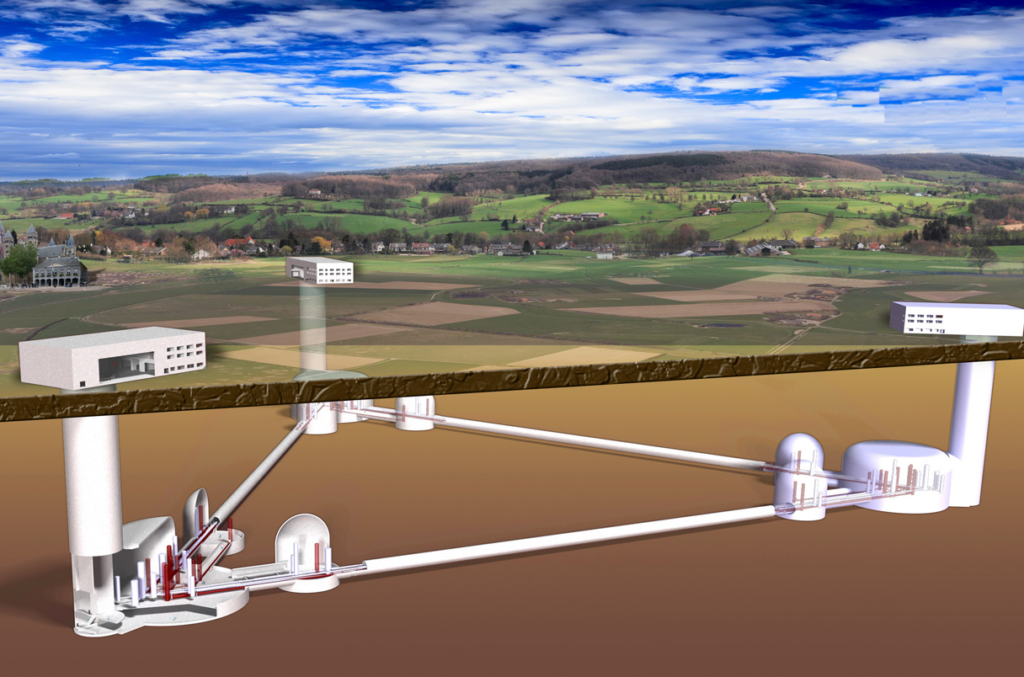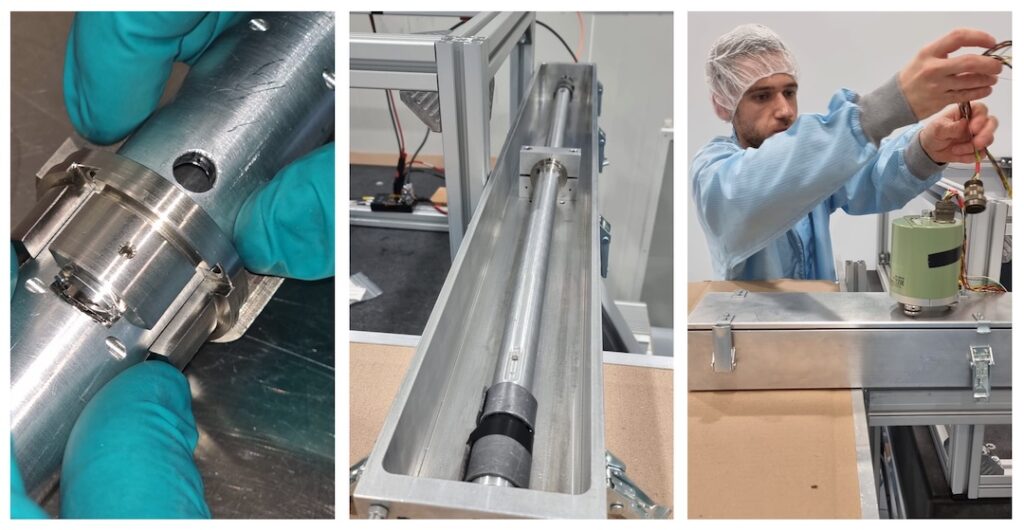In 2021 Innoseis Sensor Technologies joined the initiative of Einstein Telescope Technologies (ETT) to further enhance the cutting-edge technologies and subsurface research related to the Einstein Telescope.
The Einstein Telescope is an advanced gravitational-wave detector that was designed to detect and observe gravitational waves. Predicted by Albert Einstein’s theory of general relativity, Gravitational waves are defined as waves or curves in the composition of spacetime (mathematical model that combines space and time into a single continuum). These are caused by violent cosmic events where (enormous) objects like black holes or neutron stars collide.

Unlike its predecessors, LIGO (Laser Interferometer Gravitational-Wave Observatory) and Virgo, the Einstein Telescope is planned to be an underground observatory with an enhanced sensitivity. Placing the observatory underground will affect the precision of gravitational wave measurements due to the reduction of environmental disturbances like seismic noise and other vibrations. The enhanced sensitivity will provide the opportunity for gravitational wave detection from a wider range of cosmic events and over longer distances. Furthermore, the more sensitive telescope will observe new sources such as the fusion of intermediate-mass black holes, and plans to give more detailed insights into astrophysical phenomena like blackhole information, neutron star collisions and the behaviour of matter in gravitational events.

Even though its sensitivity will provide a multitude of opportunities, there are some challenges that come with this innovation. The underground location of the observatory and the extreme sensitivity can cause wave detection to be disturbed by external factors such as seismic and atmospheric motion. To minimize these disturbances, elaborate mechanical seismic attenuation systems have been designed to isolate the detectors from these unwanted vibrations. However, seismic motion also modulates the local gravitational field in a way that can not be mechanically suppressed. These signals may interfere with the gravitational wave signals arriving from astrophysical sources. This noise, known as Newtonian, or Gravity Gradient noise will limit the performance of gravitational wave detectors. The best know approach to solving this problem is active noise suppression – like a noise cancelling headphone – for the seismic activity nearby the detector. If the seismic wave fields can be measured, the effects can be subtracted from the detector output. This is where Innoseis Sensor Technologies’ solutions can play a major role.
How can Innoseis Sensor Technologies contribute to the success of the ET?
Innoseis Sensor Technologies is able to contribute to the success of ET through the development of specialized sensing technology. The company’s highly sensitive MEMS accelerometers will be able to detect the slightest seismic vibrations in sensor networks around the detectors main components. Furthermore, the ability to detect the seismically induced fluctuating density distributions underground will also be crucial, this is where gravity gradiometry comes into play.
Gravity gradiometry is a geophysical technique used to measure variations in the Earth’s gravitational field. Unlike traditional gravity measurements that provide information about the strength of gravity at a specific point, gravity gradiometry focuses on measuring changes in the gravitational field’s gradient or rate of change. The technique involves using specialized instruments known as gravity gradiometers. These instruments are extremely sensitive to minute changes in gravitational acceleration. By measuring the differences in gravitational acceleration across a distance of roughly one meter, the instrument can provide data on how the gravitational field changes across a given area.
Practical applications
Gravity gradiometry is particularly useful when studying areas with complex subsurface structures or when traditional gravity measurements might not provide sufficient detail. The collected data can be processed and analyzed to create detailed maps that reveal subsurface density variations, which, in turn, provide insights into the underlying geological and environmental conditions.
Therefore, gravity gradiometry can be useful in applications important to the global issues related to energy supply and climate change, such as;
- Seismic monitoring of underground C02 storage: Innoseis specialises in advanced seismic sensing technologies. These are crucial for monitoring the subsurface integrity and detecting any potential leaks at CO2 storage sites, ensuring the safe and effective storage of captured carbon.
- Mineral exploration: This technique aids in detecting variations in density and can be used to locate mineral deposits, essential ingredients for batteries and electrification.
- Geothermal exploration: Gravity gradiometry can be used to study variations in temperature and density below the Earth’s surface, providing insights into geothermal reservoirs.
- Environmental studies: It can help monitor ground stability and detect underground voids, contributing to studies related to sinkholes and land subsidence.
- Civil Engineering: Gravity gradiometry can provide information about the composition and structural integrity of the Earth’s subsurface, aiding in construction and infrastructure projects
What has Innoseis Sensor Technologies achieved so far?
A gravity gradient is an extremely subtle signal, and while you could measure this with a large elaborate setup, we set ourselves the goal to develop a device which can be deployed, moved and maintained with ease. At Innoseis we like to challenge ourselves with the aim to further technology and make groundbreaking solutions available for everyone.
The main approach to the gravity gradiometer is a pure mechanical system. By relying on mechanics rather than electronics, we aim to enhance long term operation, robustness and reducing potential points of failure. Of course there is still high-end electronics required to process the signal produced inside the device, but they can be placed either in a static controlled environment or even offloaded away from the main device. Compared to current solutions our device is designed to be installed by a single person, for the purpose of a single measurement or for long term monitoring, and therefore is required to be small and lightweight.

Over the course of the past 24 months our engineers and modeling experts have worked on mathematical models and created prototype setups to fully understand and verify each aspect of the mechanical and signal chain characteristics. This with the aim to identify the main challenges and noise sources within this novel device. Often times our engineers are challenged by the performance and availability of measurement equipment and suitable test environments. One can imagine that such precise measurements can not merely be done on a desk as during validation it is desirable to be able to measure at least an order of magnitude better than the signal to be observed.
These stringent requirements, the need for specialised and purpose build setups, and precise measuring equipment are what motivates the Innoseis team and allows us to push the boundaries of technology. The achievements so hare are no small feat and we can report that Innoseis was able to get a thorough understanding of the real life implications of such a small and industrialised gravity gradiometer. Based on the insight gained within the ETT project so far improvement have been identified that demonstrate gravity gradiometer performance by an order of magnitude better than the current state-of-art for comparable devices.
About the Einstein Telescope Technologies Project
The Einstein Telescope is a future underground observatory designed for detecting gravitational waves, potentially located at the Netherlands-Belgium-Germany border. The “Einstein Telescope Technologies” initiative involves 12 institutions and companies collaborating on cutting-edge technologies, subsurface research, and spin-offs for various sectors. It addresses challenges like vibration-free cooling, sensor improvement, and noise reduction. The project’s broader applications include innovations like GPS. The effort aims to position Dutch industry for ET-related orders and strengthen regional collaboration. The telescope fills a gap in current observatories’ sensitivity to gravitational waves, enhancing our understanding of the universe. The project is made possible by the following organisations:
